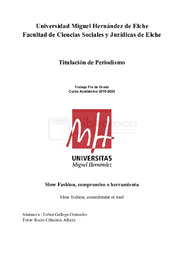Por favor, use este identificador para citar o enlazar este ítem:
https://hdl.handle.net/11000/8287Registro completo de metadatos
| Campo DC | Valor | Lengua/Idioma |
|---|---|---|
| dc.contributor.advisor | Cifuentes Albeza, Rocío | - |
| dc.contributor.author | Gallego Cremades, Esther | - |
| dc.contributor.other | Departamentos de la UMH::Ciencias Sociales y Humanas | es |
| dc.date.accessioned | 2021-09-14T16:37:32Z | - |
| dc.date.available | 2021-09-14T16:37:32Z | - |
| dc.date.created | 2021-02 | - |
| dc.date.issued | 2021-09-14 | - |
| dc.identifier.uri | http://hdl.handle.net/11000/8287 | - |
| dc.description.abstract | Son muchas las empresas que apuestan por estrategias de marketing digital para limpiar su imagen, sucede en cualquier ámbito y el sector de la moda forma parte de él. Estamos viviendo un momento de cambio en el consumidor, cada vez hay más usuarios interesados en dar una segunda vida a sus prendas o frenar el consumo desmesurado de aquellas marcas tachadas como fast fashion . Pero la principal pregunta que se hace el consumidor es en qué se diferencia el slow fashion del fast fashion . Kate Fletche (2007) acuña al slow fashion como la antítesis de la moda rápida, debido a que promueve el comercio justo, la fabricación ética y sostenible con el medioambiente, así como las prendas de mayor duración. Mientras que el fast fashion es la moda enfocada a capturar tendencias fugaces, proponiendo prendas accesibles, trendy y de corta duración de uso, alrededor de una temporada. Son muchas las marcas que apuestan por sumarse al movimiento slow fashion ante el crecimiento de consumidores que buscan otras alternativas al fast fashion , adquiriendo prendas con principios éticos. Algunas firmas lo hacen para fomentar una conciencia junto una transformación dentro de la industria, mientras que otras pueden estar motivadas por una limpieza de imagen. | es |
| dc.description.abstract | Many are the businesses that bet on digital marketing strategies to clean up their image. It happens in any field, and the fashion sector is part of them. We are living in a time of change in the consumer,. There are more users every day that are interested in giving their clothes a second life or in slowing down the uncontrolled consumption of those brands labelled as 'fast fashion'. Nevertheless, the main question that the consumer asks himself is: where lies the difference between slow fashion and fast fashion? Kate Fletche (2007) coins the term slow fashion as the antithesis of fast fashion, due to it promoting fair trade, a chain of production that is ethical and sustainable towards the natural environment, as well as the clothing of longer duration. Meanwhile, fast fashion is more focused on capturing fleeting tendencies, proposing accessible clothing that is trendy and of a short use duration of approximately one season. There are many brands that bet on joining the slow fashion movement in face of the increase of consumers that look for other alternatives to fast fashion by acquiring garments with ethical principles. Some firms do so to foster a conscience along with a transformation within the industry, whereas other firms might be motivated to do so to clean up their image. | es |
| dc.format | application/pdf | es |
| dc.format.extent | 35 | es |
| dc.language.iso | spa | es |
| dc.rights | info:eu-repo/semantics/openAccess | es |
| dc.subject | moda | es |
| dc.subject | fashion | es |
| dc.subject | filantropía empresarial | es |
| dc.subject | responsabilidad social corporativa | es |
| dc.subject | fast fashion | es |
| dc.subject | slow fashion | es |
| dc.subject | business philanthropy | es |
| dc.subject | corporate social responsibility | es |
| dc.subject.other | CDU::0 - Generalidades.::070 - Periódicos. Prensa. Periodismo. Ciencias de la información | es |
| dc.title | Slow Fashion, compromiso o herramienta | es |
| dc.title.alternative | Slow fashion, commitment or tool | es |
| dc.type | info:eu-repo/semantics/bachelorThesis | es |

Ver/Abrir:
PER_TFG_GALLEGO_CREMADES_ESTHER.pdf
3,06 MB
Adobe PDF
Compartir:
 La licencia se describe como: Atribución-NonComercial-NoDerivada 4.0 Internacional.
La licencia se describe como: Atribución-NonComercial-NoDerivada 4.0 Internacional.
.png)